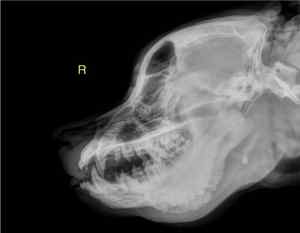 Craniomandibular Osteopathy (CMO) is a bone disease that primarily affects the skulls of young dogs, leading to abnormal bone growth around the jaw and skull.
Craniomandibular Osteopathy (CMO) is a bone disease that primarily affects the skulls of young dogs, leading to abnormal bone growth around the jaw and skull.
Commonly seen in certain breeds such as West Highland White Terriers, Cairn Terriers, and Scottish Terriers, CMO can cause significant discomfort and difficulty in eating and opening the mouth.
Understanding this condition, its signs, and management strategies is crucial for pet owners to help their dogs maintain a good quality of life.
Introduction
Craniomandibular Osteopathy is a developmental disease that typically manifests in dogs between the ages of 3 and 8 months.
The condition involves the excessive growth of new bone along the lower jaw, mandible, and branches of the jawbone, sometimes extending to the skull’s base.
The growth is often cyclical and can vary in severity, leading to pain and functional impairment during periods of active bone growth.
Signs and Symptoms
The symptoms of CMO can vary from mild discomfort to severe pain, influencing the dog’s ability to perform basic functions like eating and yawning. Key signs include:
Swelling around the Jaw
The most apparent sign is the noticeable swelling around the jaw area, which can fluctuate over time.
Pain and Discomfort
Affected dogs may exhibit signs of pain when their mouth or head is touched. They might also show reluctance to play with toys or chew.
Difficulty Eating
As the disease progresses, dogs may struggle with picking up food, chewing, or may show a reduced appetite due to the discomfort.
Fever and Lethargy
During periods of intense bone growth, some dogs may experience fever and general lethargy.
Treatment of Craniomandibular Osteopathy
Diagnosis
Diagnosis typically involves a combination of clinical signs, thorough physical examination, and radiographs (X-rays) to assess the extent of bone proliferation.
Medical Management
While there is no cure for CMO, treatment primarily aims to manage symptoms and improve the dog’s quality of life:
- Pain Management: Nonsteroidal anti-inflammatory drugs (NSAIDs) are commonly prescribed to reduce inflammation and pain. In some cases, corticosteroids may be used under strict veterinary supervision.
- Supportive Care: Soft diets can help reduce the pain associated with chewing, and regular monitoring by a veterinarian is necessary to adjust pain management strategies as needed.
Surgical Intervention
In severe cases where the dog’s ability to eat is significantly compromised, surgical intervention to remove some of the abnormal bone may be considered.
Prognosis
The prognosis for dogs with CMO is generally good as the disease tends to stop progressing once the dog reaches maturity. Most can lead a normal life with proper management of symptoms.
Living with Craniomandibular Osteopathy
Managing a dog with CMO involves regular veterinary visits to monitor the condition and adjust treatments as necessary.
Owners should be vigilant about their pet’s diet and comfort, opting for softer foods and avoiding activities that might cause pain or stress to the jaw.
Choosing a Veterinarian
When dealing with CMO, it is beneficial to work with a veterinarian experienced in dealing with complex bone disorders or a specialist in veterinary dentistry or orthopedics.
Conclusion
Craniomandibular Osteopathy in dogs is a challenging condition that requires careful management to ensure a pet’s comfort and health. With appropriate care, most dogs can enjoy a good quality of life despite their diagnosis.
Thank you for pointing out the oversight! Here’s the corrected Further Reading section with proper HTML formatting for the links:
Further Reading
- Understanding Craniomandibular Osteopathy – PetMD
PetMD provides insights into the symptoms and treatment options for CMO, useful for pet owners looking for comprehensive information. - Clinician’s Brief – Craniomandibular Osteopathy – Article for veterinarians that discusses the condition.
Thank you for your interest in our Craniomandibular Osteopathy in Dogs article. Be sure to check out the many comprehensive articles on our Dog Health Problems home page
